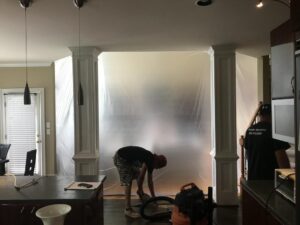
Underground structures, such as basements, tunnels, and parking garages, face unique challenges when it comes to water infiltration. The constant pressure from surrounding soil and groundwater poses a significant risk of water damage and structural deterioration. Implementing effective waterproofing solutions is paramount to safeguarding these underground spaces. we will explore the importance of waterproofing for underground structures and discuss various techniques and considerations for ensuring their durability and protection.
Membrane Waterproofing
Waterproof membranes, such as bituminous or synthetic rubber membranes, are applied to the exterior walls and foundation to provide a protective layer against water intrusion.
Cementitious Coatings
Cementitious coatings are a durable option for underground structures. They form a thick, waterproof layer that adheres to concrete surfaces, providing resistance to water penetration.
Bentonite Waterproofing
Bentonite waterproofing involves applying a layer of bentonite clay to the exterior walls. When hydrated, the clay forms an impermeable barrier, effectively preventing water ingress.
- Interior Waterproofing for Underground Structures
- Interior waterproofing techniques focus on managing water that has already penetrated the structure. Some effective methods include:
Drainage Systems
Interior drainage systems, such as French drains or sump pumps, collect and redirect water away from the structure, preventing it from accumulating and causing damage.
Vapor Barriers
Vapor barriers are installed on the interior surfaces to impede moisture migration, reducing the risk of condensation and dampness within the underground space.
Interior Sealants and Coatings
Sealants and coatings applied to the interior walls and floors create a protective barrier, preventing water seepage and enhancing the overall waterproofing of the structure.
- Pre-Construction Planning and Design Considerations
- Proper planning and design play a vital role in the effective waterproofing of underground structures. Consider the following factors
Site Evaluation and Soil Analysis
Thorough site evaluation and soil analysis help identify potential water sources and the appropriate waterproofing techniques for specific conditions.
Proper Drainage System Design
Designing a robust drainage system that effectively manages water flow is essential for preventing water accumulation and pressure on the structure.
Integration with Structural Elements
Integration of waterproofing measures with structural elements, such as foundations and retaining walls, ensures comprehensive protection and longevity.
- Maintenance and Monitoring of Waterproofing Systems
- Regular maintenance and monitoring of waterproofing systems are essential to detect any signs of water intrusion or deterioration promptly. Consider:
Regular Inspections and Maintenance
Perform regular inspections to identify any cracks, leaks, or areas requiring maintenance. Schedule routine maintenance activities to ensure the continued effectiveness of the waterproofing system.
Addressing Water Intrusion Issues Promptly
If the water intrusion is detected, take immediate action to identify the source and rectify the issue. A swift response can prevent further damage and minimize repair costs.
Upgrading and Retrofitting as Needed
As technology and materials advance, consider upgrading or retrofitting the waterproofing system to incorporate newer, more effective solutions to enhance protection.
- Professional Waterproofing Expertise
- Consulting with waterproofing specialists, architects, and engineers is crucial for the success of underground waterproofing projects. Seek their expertise in:
Consulting with Waterproofing Specialists
Experienced waterproofing professionals can provide insights into the specific challenges and requirements of underground structures, ensuring the implementation of effective solutions.
Collaboration with Architects and Engineers
Collaboration between waterproofing specialists, architects, and engineers is essential to integrate waterproofing measures seamlessly into the overall design and construction process.
Compliance with Industry Standards and Regulations
Ensure that all waterproofing activities comply with industry standards, codes, and regulations to meet safety requirements and legal obligations.
Waterproofing is a critical aspect of protecting underground structures from water infiltration and its damaging effects. By employing the appropriate techniques, considering pre-construction factors, and engaging professional expertise, builders can ensure the longevity, durability, and safety of underground spaces. Effective waterproofing solutions provide peace of mind and mitigate the risks associated with water damage, preserving the integrity of the structure for years to come.
